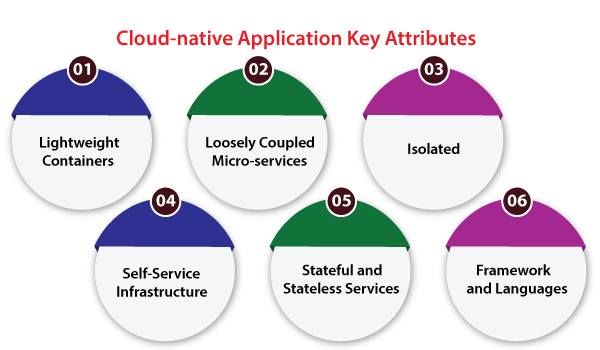Cloud-Native Applications
Introduction
The Cloud-Native applications are a group of independent, small, loosely-coupled services. Cloud-native applications are created for delivering well-identified business value, as an ability to incorporate the feedback of users for extended improvements. In other words, cloud-native applications improvement is a way for speeding-up how we create applications users wish at the pace an enterprise requires.
Cloud meaning in Cloud-native Applications
If an application is Cloud-native, specifically, it's created for facilitating automated management and consistent development experience across hybrid, public, and private clouds. Enterprises use cloud computing for increasing the availability and scalability of applications. These aspects are accomplished through on-demand and self-service provisioning of various resources. It is also automating the lifecycle of an application to production from development.
However, to completely utilize these aspects, a new way of application advancement is required.
The development of Cloud-native applications is an approach for quickly updating and building applications while reducing risk and improving quality. More specifically, it is a way to run and build fault-tolerant, scalable, and responsive applications anywhere inside the hybrid, public, and private clouds.
Benefits of Cloud-native applications
The following are a few benefits of using cloud-native applications:

- Faster release: Faster deployment displays responsiveness and agility, which are essential to remain connected in today's changing business world rapidly. If we require explaining faster deployment, we require explaining DevOps because it provides collaboration and finds the way for quick delivery. The Cloud-native applications are often the outcome of any successful DevOps as operations, development. Testing groups can efficiently and easily coordinate for each release, even when they are within geographically distinct places.
- Increased customer experience: It is necessary to build a business model, i.e., customer-centric. Constant incremental developments are crucial to the applications for improving customer satisfaction. These iterations and changes can be easily carried out. Thus, it provides us a competitive edge needed to be customer-friendly and more engaging.
- Ease of management: Various cloud automation comes with advanced and comprehensive ecosystems that make framework management easy. Constantly, the cloud is evolving to contain even the complex application over its own.
- Reduced cost: The cloud provides Containerization. The containerization process is supported via Container-orchestration open-source systems such as Kubernetes. Kubernetes currently is an industry-standard to manage resources on any cloud.
Containerization permits us to build Cloud-native abilities like compute time (pay-per-use) and server-less in milliseconds. It will add flexibility in the price to deploy and build applications.
- Reliable services: We can use the architecture of micro-services which can isolate and identify the failure impact to minimize the downtime using Cloud-native applications. With Containerization and micro-services, our applications can be made to become self-heal and fault-tolerant. Also, it improves customer-experience as the customers can like a highly reliable achievement.
Cloud-Native Applications key attributes

- Bind as lightweight containers: These applications are the group of autonomous and dependent services that can be bind as light-weight containers. It may scale-in and scale-out rapidly unlike the virtual machines. The utilization of infrastructure is optimized since the scaling unit shifts towards containers.
- Designed with various frameworks and languages: All cloud-native application services are improved using the framework and language best suited to the implementation. Cloud-native services apply the language variety, frameworks, and runtime because the cloud-native application is polyglot. The fine-gained method for improving micro-services enables them to select the best framework and language for a particular task.
- Developed as loosely-coupled micro-services: Various services that reside inside the similar application identify each other from the runtime of an application. Application architecture and elastic infrastructure, if integrated properly, may be scaled-out with high performance and efficiency.
- Isolated from the operating system and server dependencies: These applications do not have any closeness for an individual machine or a specific operating system. They implement at a higher level of abstraction. Only, the exception is if any micro-service requires certain abilities, including GPUs (Graphics Processing Units) and SSDs (Solid-State Drives) that can be facilitated via the machine's sunset exclusively.
- Deployed on cloud, elastic, self-services infrastructure: Cloud-native applications can be deployed on elastic, shared, and virtual infrastructure. It can be aligned using underlying infrastructure for shrinking and growing dynamically.
- Architecture using a separation of stateful and stateless services: Durable and persistent services follow a distinct format that ensures higher resiliency and availability. Stateless services are independent of the stateful services. Persistence can be defined as an aspect that should be viewed inside the context increasingly with statelessness, state, and micro-storage environment.
|


 For Videos Join Our Youtube Channel: Join Now
For Videos Join Our Youtube Channel: Join Now









